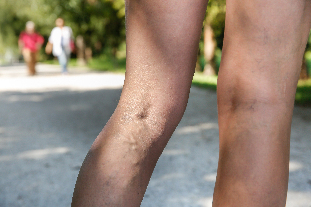Varicose veins (varicose veins) is a chronic disease characterized wasted away to knotty extension of the veins with decreased outflow of blood and the stagnation of the venous system.
In the beginning of varicose veins does not cause any inconvenience and it is only a cause of cosmetic defect: appearance translucent through the skin with knotted veins blue-brown tint.

The symptoms of varicose veins
You will need to contact phlebologist, if they found themselves in at least one of the following symptoms of varicose veins:
- transparent through the skin clearance of the veins in the legs?
- feeling of heaviness in the legs, rapid fatigue;
- uneven brown pigmentation of the skin in the area of shins and ankles?
- recurrent pain in legs?
- edema of shins and feet, which usually appear after prolonged standing or sitting with their legs?
- intermittent occurrence of cramps in the muscles of the lower limbs;
- in the later stages of the disease – azwenne blemishes on the skin of the legs or in the region of the joints.
By observing the same the first signs of the disease of the veins, don't hesitate and immediately consult a specialist-a phlebologist. The latest diagnostic equipment to get rid of varicose veins, it allows experienced doctors to identify the progression of the disease at an early stage and prevent complications.
The main causes of the appearance of varicose veins
At varicose expansion of veins often lead to:
- inherent weakness of the venous wall, which predisposes to the development of varicose veins and is it hereditary?
- gender – women suffer from varicose veins of legs two times more often than men. In accordance with one of the theories, this is due to wear high heels?
- the prolonged stay on his feet. Often varicose veins of the suffering of the people, the occupations associated with the work "feet": salespeople, teachers, hairdressers, and the others?
- age – varicose veins most often develops after 45 years?
- physical inactivity, work that requires prolonged standing or sedentary life?
- needless strenuous physical exercise?
- obesity and excessive weight.
The stage of varicose veins
1 phase – phase payment. Expressed manifestations of venous insufficiency is not. Worried about the discomfort and quick fatigue of the feet.
2 phase – phase subcompensation. Appear pain, the veins begin to bulge up under the skin in the form of nodes.
3 phase – phase decompensation. It is characterized by a pronounced reduced outflow of blood from the lower extremities, develop trophic disorders of the skin, the formation of long not healing of trophic ulcers.
In clinic for the treatment of varicose veins should contact already if you see the symptoms of the first stage – so it will be easier and more quickly get rid of the disease, as well as preventing the development of complications.
Complications of varicose veins
Lipodermatosclerosis \ white atrophy of the skin
Lipodermatosclerosis is fibrous regeneration of the skin and subcutaneous fat. The cloth when it loses its elasticity and mobility. Extreme form of lipodermatosclerosis white atrophy of the skin.
Food eczema \ dermatitis
Eczema occurs in the latter stages of varicose veins and is an inflammation and redness of the skin on the feet. With the evolution varicose deteriorating nutrition of the skin, which then leads to the appearance of trophic ulcers.

Acute venous thrombosis
On the basis of this complications of varicose veins – education blood clot (thrombus) in deep veins of the legs, which with the flow of blood can enter the heart or lungs. The situation requires immediate medical help.
Thrombophlebitis
Thrombophlebitis is the inflammation of the wall of the vein with the formation of a blood clot, closing the lumen of the vessel. In most cases, thrombophlebitis is a consequence of the "running" form of varicose veins.
Trophic ulcer
The long-not cure defect of the skin, development in the context of venous stasis, requires a comprehensive treatment.
Bleeding of varicose veins
The bleeding is most likely to arise from trophic venous ulcers, however, can be and from extensive veins. First aid in case of bleeding from varicose veins: you need to apply a pressure bandage directly to the location of the bleeding, elevate the leg above the horizontal plane, further hospitalization.
Prevention of varicose veins
In order not to cope with varicose veins, you should:
- it is possible to avoid prolonged standing or sitting? to give up the habit to sit for a long time the location of the foot on the leg?
- to avoid the appearance of unnecessary pounds?
- regularly engaged in physical culture (gymnastics, swimming, etc.)?
- get comfortable shoes, try not to wear shoes with heels every day.
The treatment of varicose veins
Today, the removal of varicose veins in my legs often occurs without traumatic interventions, as it was before 10-15 years. Recovery after the treatment takes a minimum of time!




































